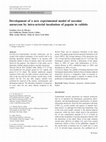Papers by ivanilson costa

Neuroradiology
Introduction Experimental saccular aneurysms can be created with surgical techniques of the arter... more Introduction Experimental saccular aneurysms can be created with surgical techniques of the arterial wall or by injecting pancreatic elastase. Papain is an enzyme with properties similar to those of elastase, and it has not been tested for this purpose. The objective of this study was to determine whether papain produces saccular aneurysms. Methods Eleven New Zealand white rabbits (1.9–3.0 kg) were divided into two groups: group I (n = 8)—papain, and group II (n = 3)—sham. The animals underwent surgical exposure of the neck; the right common carotid artery was used as the test and the left common carotid artery as the control. On the 21st day after surgery, animals were sacrificed for removal of the arteries, measurements, and histological analysis. We determine formation of aneurysm to occur when the test artery dilated compared to the control. Results There was no aneurysm formation in the sham group. The papain group showed aneurysm formation in all cases (100%). The average diameter of the aneurysms was 3.8 ± 1.4 mm and the average length was 16.7 ± 6.0 mm. The histological analysis showed a destruction of the elastic fibers in 100% of cases, mild inflammation in 62.5%, intimal fibrosis in 50%, endothelial injury in 100%, and thrombosis in 100% of cases. Conclusion Papain was capable of forming aneurysms with histological characteristics similar to those of elastase-induced aneurysms; however, a comparative study is necessary to determine whether the papain is superior to elastase in the production of experimental saccular aneurysms.






Uploads
Papers by ivanilson costa